The National Technical Education and Skills Development Plan (NTESDP) 2023-2028
MaGaling at MakaBagong TVET para sa Bagong Pilipinas:
TVET as a Pathway to Recovery and Socio-Economic Transformation
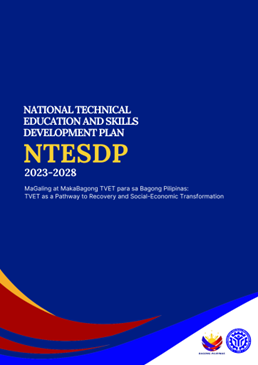
Related files can be downloaded at http://bit.ly/NTESDPdownload
TESDA is mandated under Section 21 of RA 7796 (TESDA Law) to formulate a “comprehensive development plan” for middle-level workforce that will guide all stakeholders – government, industry, academe, local and international organizations, students, and the public – for the development of the middle-level workforce.
The Technical Education and Skills Development Authority (TESDA) proudly unveils the National Technical Education and Skills Development Plan (NTESDP) 2023-2028, a comprehensive roadmap designed to empower the Filipino workforce with the skills and knowledge necessary to thrive in the rapidly evolving global economy.
Click to watch the NTESDP Audio-Video Presentation
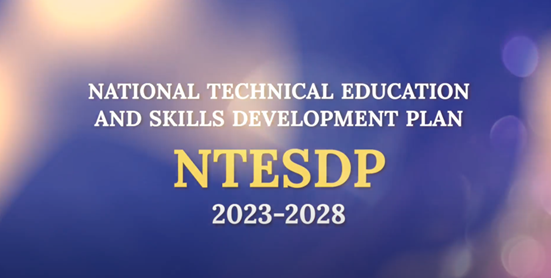
The NTESDP 2023-2028 is anchored on the vision of A Globally Recognized Philippine TVET as a Catalyst for Education and Lifelong Learning, Workforce, and Socio-Economic Transformation, with Area-based Demand-driven TVET as its central strategy. This overarching vision aligns with the objectives of Philippine Development Plan (PDP), especially Chapter 2.2. Transformative Lifelong Learning Opportunities for all Ensured and Chapter 4 Income-Earning Ability Increased. It is also aligned with the Philippine Labor and Employment Plan 2023-2028, other sectoral plans, national directives, legislations, and international policies.
The National Technical Education and Skills Development Plan (NTESDP) 2023-2028 aims to provide access to high-quality opportunities for lifelong learning, as well as to provide Filipinos with smart and innovative skills. The plan focuses on creating future-ready TVET programs, advancing ladderized education, and pursuing collaborations in recognizing relevant courses offered by NGAs, technical-vocational institutions and HEIs (including state and local universities and colleges). It also aims to increase enterprise-based training (EBT), particularly emphasizing dual training systems, apprenticeships, and learnerships, and recognizing relevant courses offered by NGAs, technical-vocational institutions and HEIs (including state and local universities and colleges).
Philippine TVET has to proactively address the urgency for constant skilling, reskilling, and upskilling while cultivating the critical thinking, communications, collaboration, adaptability, futures thinking, and higher-order cognitive skills of the country’s workforce and entrepreneurs. Lifelong learning as a primordial philosophical anchor of Philippine TVET summons a level of quality and availability of training and skills as well as mindset that will make an important difference in employment outcomes of individuals. At the country level, lifelong learning calls for crafting new skills policy and recalibrated TVET directions and programs to help shape workforce readiness and national competitiveness amidst global economic developments and the Fourth Industrial Revolution.
At the same time, Philippine TVET has to reinforce its foundations as the country’s primary vehicle of access, inclusivity, and mobility that provides hope and practical economic opportunities for those who are hampered by poverty, geographical and cultural isolation, physical disadvantages, and other challenges. It has to lead in providing the platforms needed to enable the country’s workforce to transition in the green, digital, and knowledge economies and to move across industries and occupations, along career paths that may be nonlinear. It has to champion the flexible pathways between different levels of formal education and for the recognition and development of skills acquired outside formal education.
NTESDP Priority Sectors
For the NTESDP 2023-2028, there are ten (10) identified priority sectors, which are the country’s key employment generators.
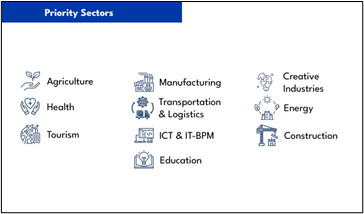
- Agriculture
- Manufacturing (including food manufacturing and electronics)
- Creative Industries
- Health
- Transportation and Logistics
- Energy
- Tourism
- Information and Communications Technology (ICT) and IT-BPM
- Construction
- Education
NTESDP 2023-2028 Framework and Strategic Pillars
STRATEGIC FRAMEWORK

The NTESDP aims for Philippine TVET shall acquire the same level and respect and recognition given to other TVET systems in the other parts of the world and shall serve as a primary platform for lifelong learning that can be accessed by every Filipino in search of professional advancement and continuing education.
The mission of the TVET sector shall be "To promote, provide, and support accessible, inclusive, equitable, relevant, and high quality TVET". The success of the mission will be demonstrated by the impact of interventions such as: (a) increased number of Filipinos exhibiting public acceptance and recognition of the value of TVET; (b) increased number of Filipinos from marginalized groups or communities provided with TVET opportunities; (c) increased number of TVET programs that address changing work needs; and (d) increased number of foreign employers that recognized and accepted Philippine TVET graduates with their certifications and qualifications.
The NTESDP has six (6) Strategic Pillars and all the strategies shall be implemented with the Area-based Demand-driven TVET as the central strategy.
OUTCOME AND STRATEGIES
Strategic Pillar 1: Modern and responsive technical and vocational training and lifelong learning advanced and reinforced
Given the urgency to address new relationships between education, the changing world of work, evolving needs of industries and communities in the era of the Fourth Industrial Revolution, the NTESDP 2023-2028 shall aggressively pursue the advancement of technical and vocational training and lifelong learning. It shall lead in the creation of open and flexible educational structures, recognizing work experience as a part of learning. It shall create a learning culture that permits individuals to expand their intellectual horizons, and provide opportunities and access to all learners, especially among members of marginalized communities, to acquire and to constantly improve professional skills and knowledge, and to engage positively in society to utilize the fruits of economic and technological change.
To bring about this outcomes, the NTESDP will pursue the following strategies:
- Design national and regional workforce and skills roadmaps and plans
- Innovate pedagogy, skilling, upskilling, re-skilling and assessments of TVET providers and incentivize high-performing, quality training institutions
- Drive urban and rural industry development and strengthen community and area-based, enterprise-based, and demand-driven future-ready TVET programs
- Design sector-specific programs that address the needs of industries in identified key employment generators, emerging sectors, including entrepreneurship in the green and blue economy, the Fourth Industrial Revolution, and the Future of Work
- Strengthen the capacity of national and local training systems to deliver workforce readiness and technical-vocational training for vulnerable out-of-school youth and people in marginalized situations
Strategic Pillar 2: Quality and productivity of workforce enhanced
The NTESDP 2023-2028 shall work for full recognition, appreciation, and employability of TVET learners and graduates, allowing them to receive better employment options and higher salaries and improve their career mobility. It shall provide platforms and mechanisms of learning that address the needs for higher level of competencies and skills, especially in the various high value-added, high-tech sectors where there is utilization of a higher level of technology, operations and work processes. It shall broaden access to quality TVET, especially targeting youth, MSMEs, cooperatives, women, PWDs, IP communities, and groups in marginalized situations for gender equality and social inclusion.
The specific strategies are the following:
- Ensure TVET opportunities are available to all who want to access them, and ensure equality of access across the system
- Widen learning and educational opportunities for the youth, MSMEs, cooperatives, women, PWDs, IP communities, and groups in marginalized situations for gender equality and social inclusion
- Increase the number of youth and adults with entrepreneurship skills
- Work with DOLE and industry boards on programs geared towards increasing employability and wages for TVET graduates
Strategic Pillar 3: Quality assurance on certifications, standards, equivalencies, and qualifications strengthened
The NTESDP 2023-2028 shall be committed to quality assurance as a fundamental anchor for the comparability and recognition of qualifications of Philippine TVET at both the national and international levels. It shall ensure the validity, consistency, and trustworthiness of Philippine qualifications and certificates through reliable and standardized quality assurance arrangements and harmonized rating systems and mechanisms. It shall work on improving stakeholders’ confidence and trust on the assessment and qualification processes and that the certifications gained by TVET graduates valid and reliable testaments to their knowledge, skills and wider competences.
Specifically, the NTESDP will:
- Improve national and regional qualification frameworks to increase portability of qualifications and develop progression pathways for learner and labor mobility
- Increase awareness and accelerate the operationalization / implementation of the Philippine Qualification Framework (PQF), and integrate integrating Philippine Skills Framework (PSF) competencies in TVET courses
- Ensure clear pathway for TVET towards lifelong learning, higher education, and regional mobility (including Strengthened Technical Vocational Education Program (STVEP) and SHS Technical-Vocational-Livelihood (TVL) Track)
- Pursue TVET internationalization by benchmarking skill standards, competency assessment and certification with international standards and referencing
- Operationalize the Philippine Credit Transfer System to optimize learner-to-worker mobility, higher TVET qualifications, and TESDA's distinctive area of competence
Strategic Pillar 4: Collaborations with industry, government, academe, labor, and other stakeholders expanded and sustained
The Plan shall strengthen partnerships with industry, local government units, universities and colleges, employer associations as well as other community stakeholders. It shall foster regular and active communication between TVET partners and TVET providers and provide enabling mechanisms to share data and insights relevant to curriculum and program development, skills framework development, emerging jobs, and job reskilling and upskilling.
To bring about these collaborations with other TVET stakeholders, the NTESDP will pursue the following strategies:
- Increase participation and ownership by employers and other stakeholders for more relevant and responsive enterprise-based trainings and apprenticeship programs
- Establish seamless coordination and relationship with DepED, CHED, TVIs, NGAs, HEIs (including SUCs and LUCs) for TVET recognition in the credit transfer system
- Manage autonomy for public training providers and strengthen support provision to private training providers
- Develop capacity building programs for Public and Private TVET Training Institution Trainers
- Establish physical platforms for collaborations on learning, innovation, and entrepreneurship such as the TVET Innovation Centers, Maker's Space, and Incubation Hubs
- Strongly campaign for public understanding, appreciation, high regard, and support of TVET
- Progressively devolve TVET community-based training and institutionalization of Community Training and Employment Coordinators (CTECs)
- To ensure linkages of training to employment platform of DOLE to attain decent, sustainable, and quality jobs and livelihoods
Strategic Pillar 5: Transformative and innovative TVET ecosystem organized and strengthened
We shall strengthen the interconnectedness of the factors that are crucial to the operations of the Philippine TVET ecosystem such as learner information management system, research and development, monitoring and evaluation, communication and promotion, social inclusion, and sustainable practices.
The NTESDP will pursue the following
- Establish inter-operability of labor market information systems and management information systems on learners/workers as well as current, critical, and emerging skills and jobs
- Nurture a strong culture of research and innovation to generate knowledge and new policies, products, systems, and processes for efficient TVET delivery and optimal learning
- Establish a robust mechanism for monitoring and evaluation
- Instill and communicate value of TVET culture
Strategic Pillar 6: Philippine TVET System and Governance Harmonized
Finally, we shall strongly and widely promote TVET’s pivotal role in lifelong learning and its significant position in the Philippine education sector. It shall advocate and campaign for increased financing and support from government as well as investments and participation from the private sector. It shall ensure that the TVET culture and its implementation is felt at the grassroots via formal and informal mechanisms and structures.
The Plan shall pursue the following strategies:
- Instill and deepen organizational culture and identity of TVET as a sector
- Advocate for increased public investments, sustainable, and expanded TVET financing
- Develop and promote a national policy for lifelong learning
- Strengthen the functionalities of Regional/Provincial TESD Committees
- Harmonize the tri-focalized system of education for lifelong learning and streamline employment, livelihood, and support programs of government
To see details of the launch of the NTESDP, click the following links:
TESDA News: TESDA LAUNCHES DEVELOPMENT PLAN FOR TVET SECTOR
PTV Video News Clip1 News Clip2: TESDA launches National Technical Education and Skills Development Plan to strengthen TVET
USAID: NTESDP Launch in Pictures Message of PBBM on TESDA 29th Anniversary and Launch of the NTESDP:
NTESDP Launch - Official Pictures
NTESDP Launch - Official Video
TRIUMPHS IN TVET: THE NATIONAL TECHNICAL EDUCATION AND SKILLS DEVELOPMENT PLAN MILESTONES 2018-2022
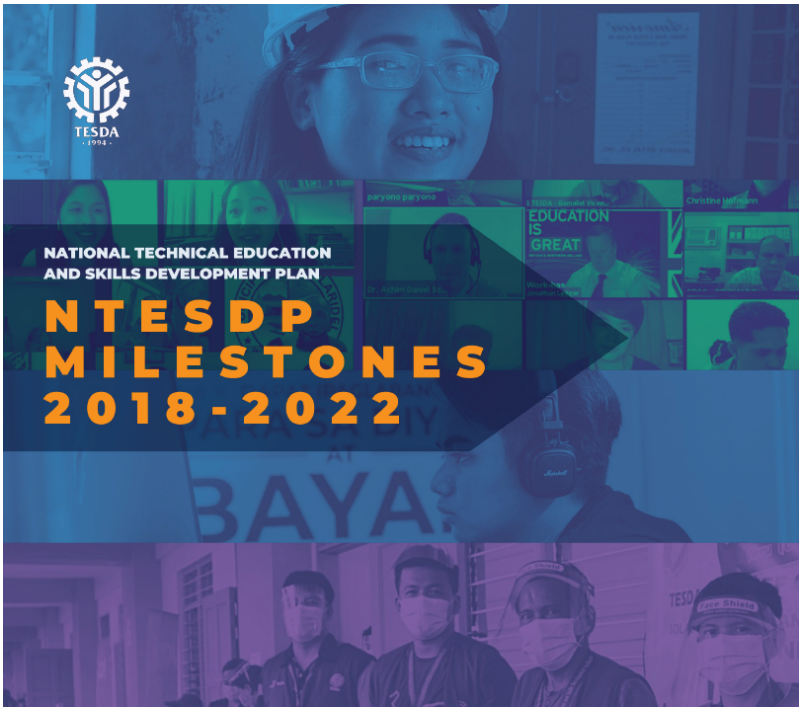
National Technical Education and Skills Development Plan 2018-2022 Milestones
The Technical Education and Skills Development Authority (TESDA) is proud to announce the publication of the National Technical Education and Skills Development Plan (NTESDP) Milestones 2018-2022. The document features the achievements and highlights of the most notable policies, programs, and projects implemented by the Technical-Vocational Education and Training (TVET) sector in pursuit of the objectives of the Plan.
As part of its mandate (under TESDA Section 21 of RA 7796) TESDA collaborated with the key players in the TVET sector – the government, industry, labor, academe, NGOs, and even learners -- to formulate and implement a comprehensive plan for Philippine TVET. The Milestones Report details how the objectives of the Plan were converted into concrete policies and programs in the concerted effort of preparing our learners and workers to the challenges in the ever-shifting World of Work for global competitiveness and work readiness. Achievements in harnessing TVET for social inclusion and reducing poverty by increasing the employability of Filipinos are also presented in the report.
The Milestones also contains how the TVET sector responded to the challenges posed by disruptions brought about by the Fourth Industrial Revolution, and of course, the COVID-19 pandemic. TESDA continued to adapt and adopt different strategies in order for the TVET providers and the sector as a whole to take advantage of the opportunities and conquer the challenges, so that the learners, communities, and the economy can become more resilient in the post-pandemic digital age.
Download a copy of the NTESDP Milestones 2018-2022 through this link: https://bit.ly/ntesdp-milestones.
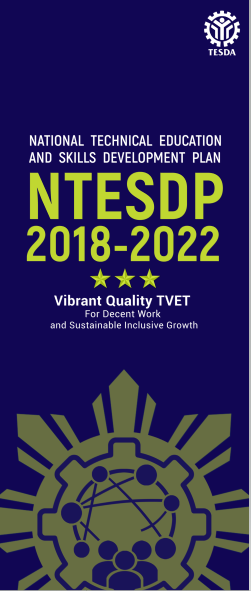
Background: Why create a Plan in the first place?
Download the NTESDP here.
TESDA is bound by law to create a medium-term (six-year) Plan for middle-level workforce that will guide all stakeholders – government, industry, academe, local and international organizations, students, and the public – for the development of the middle-level workforce.
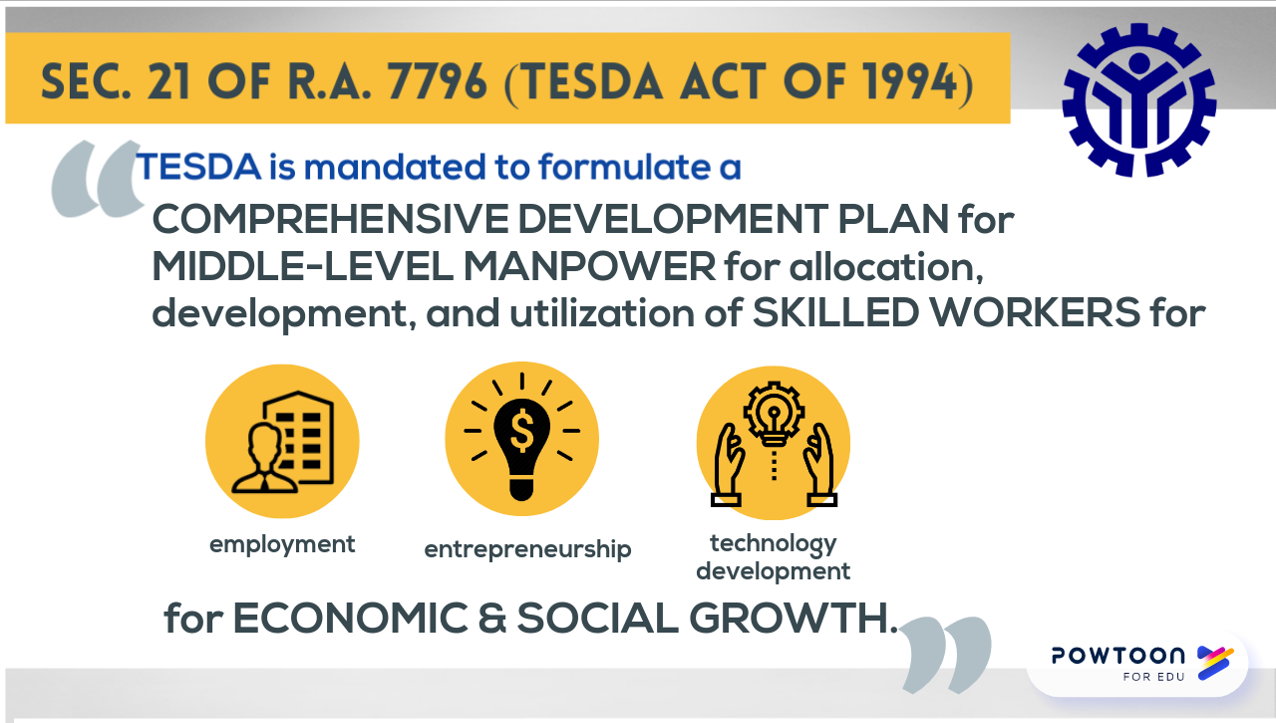
The NTESDP 2018-2022
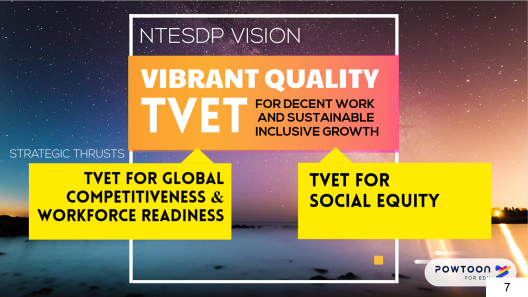 True to this mandate, the TESDA, in cooperation with its partners and relevant sectors, has formulated the National Technical Education and Skills Development Plan 2018-2022, the fourth in a cycle of such plans, to mobilize and encourage the full participation of industries, the labor sector, government units and relevant educational institutions in the development of the Philippines’ human capital resources.
True to this mandate, the TESDA, in cooperation with its partners and relevant sectors, has formulated the National Technical Education and Skills Development Plan 2018-2022, the fourth in a cycle of such plans, to mobilize and encourage the full participation of industries, the labor sector, government units and relevant educational institutions in the development of the Philippines’ human capital resources.
The National Technical Education and Skills Development Plan 2018-2022, NTESDP for brevity, serves as a compass that informs the Technical Vocational Education and Training (TVET) actors, movers, and leaders in coming up with responsive policies and implementing programs for the sector, and to support the broader development goals and objectives of the national government.
The NTESDP envisions a Vibrant Quality TVET for Decent Work and Sustainable Inclusive Growth. This overarching theme is the rallying cry that primes the TESDA and its partners to achieve the NTESDP’s primary objective of galvanizing and strengthening the TVET sector through a Two-Pronged Strategic Thrust: (1) Global Competitiveness and Workforce Readiness; and (2) Social Equity for Workforce Inclusion and Poverty Reduction.
Planning Environment
In formulating the Plan, TESDA identified, reviewed, and analyzed external and internal environments and global and local factors that affect the TVET sector. It aligned the Plan with global, national, and sectoral development plans, national education legislation, and international standards referencing systems. The planners drew contemporary lessons from labor and employment realities, such as migration; paradigm shifts in technology, particularly the fourth industrial revolution (4IR); ecology; climate change and green economy; sustainability; and gender and social equity advocacies.
The TVET Sector
Generally, the Philippines’s TVET sector has been experiencing healthy growth. But while it receives only one percent of Gross Domestic Product in government funding support, TESDA’s budget more than doubled from P2.7 billion in 2012 to P6.4 billion in 2016.
Scholarship funding has boosted enrollment and produced positive results, with the average employment rate of TVET graduates with scholarships posting higher than the average employment rate for all TVET graduates.
TVET providers are likewise enjoying unprecedented growth. In 2016, there were already 4,075 private and public institutions, compared to only 3,381 in 2007. Between 2010 and 2016, institution-based training had recorded 1.023 million enrollees, followed by community-based training with 824,000. The growth in enrollment was fueled by community-based or barangay-oriented programs. Enterprise-based training was the most successful training modality in terms of employment, but this training modality has not gained traction, with enrollees only reaching 77,000.
Further, TVET is gaining more attention as the education sector evolves and develops more sophistication, starting with the K to 12 program and onto international referencing initiatives and agreements, like the ASEAN Qualifications Framework and other mutual recognition systems. These are creating opportunities to expand TVET capacity and performance, both as an education infrastructure and a human capital development platform.
TVET has also found a place in certain subsectors of the labor and employment market. Today, TVET graduates are successfully employed in such sectors as (1) tourism (hotels and restaurants); (2) ICT; (3) health, social, community, and other services; (4) electronics; and (5) metals and engineering. The growth of certain industries like tourism, construction, and ICT is certainly benefiting TVET as these industries require more skilled workers.
As to TESDA, it has benefitted from the support of industries which have helped the Authority develop a total of 264 Training Regulations (TRs) led by construction, which has 43 TRs. Relative to this, TESDA is ensuring quality standards for providers and trainers as part of its mandate.
NTESDP’s Key Employment Generators
The NTESDP 2018-2022 has identified the country’s key employment generators and divided these into three groups.
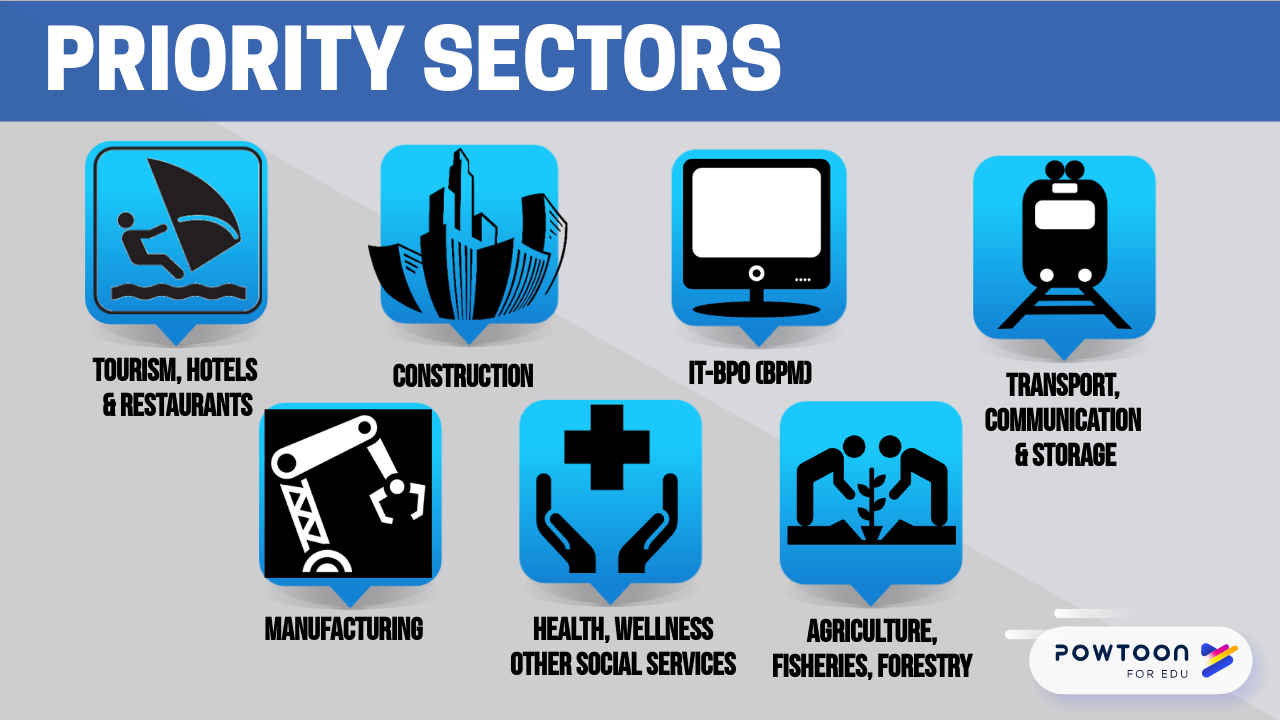 The first group consists of industries that have large employment bases and are growing very rapidly. These industries are expected to create the most number of jobs during the Plan period. These are tourism/hotels/restaurants; construction; IT-BPO (IT-BPM); and transport, communication and storage.
The first group consists of industries that have large employment bases and are growing very rapidly. These industries are expected to create the most number of jobs during the Plan period. These are tourism/hotels/restaurants; construction; IT-BPO (IT-BPM); and transport, communication and storage.
The second group consists of industries that have large employment bases but have exhibited negative or minimal growth rate in the past. However, since these industries are important to the economy in terms of value-added and employment, the government wants to revitalize and strengthen them. These are agriculture; fisheries and forestry, including agro-processing; and manufacturing. For the latter, food manufacturing is the leader, posting a 40 percent share of manufacturing gross value-added. It is followed by electronics which accounts for 50 percent of Philippine exports.
The third group is composed of industries in health, wellness and other social services with high growth rates and good economic multiplier effects.
Problems and Challenges
The NTESDP 2018-2022 has identified problem areas that challenge the TVET sector.
 The 4IR and rapid technological advancements are seen by experts to make many jobs obsolete. This would make it difficult for the country’s TVET providers to cope and catch up with the rapid pace of innovation, technological change, and advanced workforce skills requirements
The 4IR and rapid technological advancements are seen by experts to make many jobs obsolete. This would make it difficult for the country’s TVET providers to cope and catch up with the rapid pace of innovation, technological change, and advanced workforce skills requirements
Also a problem area is the low employability of Philippine TVET graduates, a mere 65 percent. TVET providers face the perennial criticism that they are providing and producing low level skills and technical education. This reality spills over to the labor economy which is characterized by the prevalence of low-value work compared to mid- to high-value jobs in a ratio of 70:30
 The full implementation of tech-voc courses under the K to 12 program has aggravated the lack of facilities and equipment, qualified trainers, and assessors in the sector, another problem area. As the Philippine TVET sector is largely supply-driven, this reality adds to the job and skills mismatch and under-employment.
The full implementation of tech-voc courses under the K to 12 program has aggravated the lack of facilities and equipment, qualified trainers, and assessors in the sector, another problem area. As the Philippine TVET sector is largely supply-driven, this reality adds to the job and skills mismatch and under-employment.
The Filipino workers’ out-migration is also creating a brain and brawn drain affecting the pool of qualified and skilled workers. In 2013, there were 10.2 million Filipinos overseas. In addition, there has been a drop in industry enterprises participating in TVET, demonstrated by the low enrollment of enterprise-based modality training even if it is the most successful modality in terms of employability, with an average employment rate of 68.9 percent.
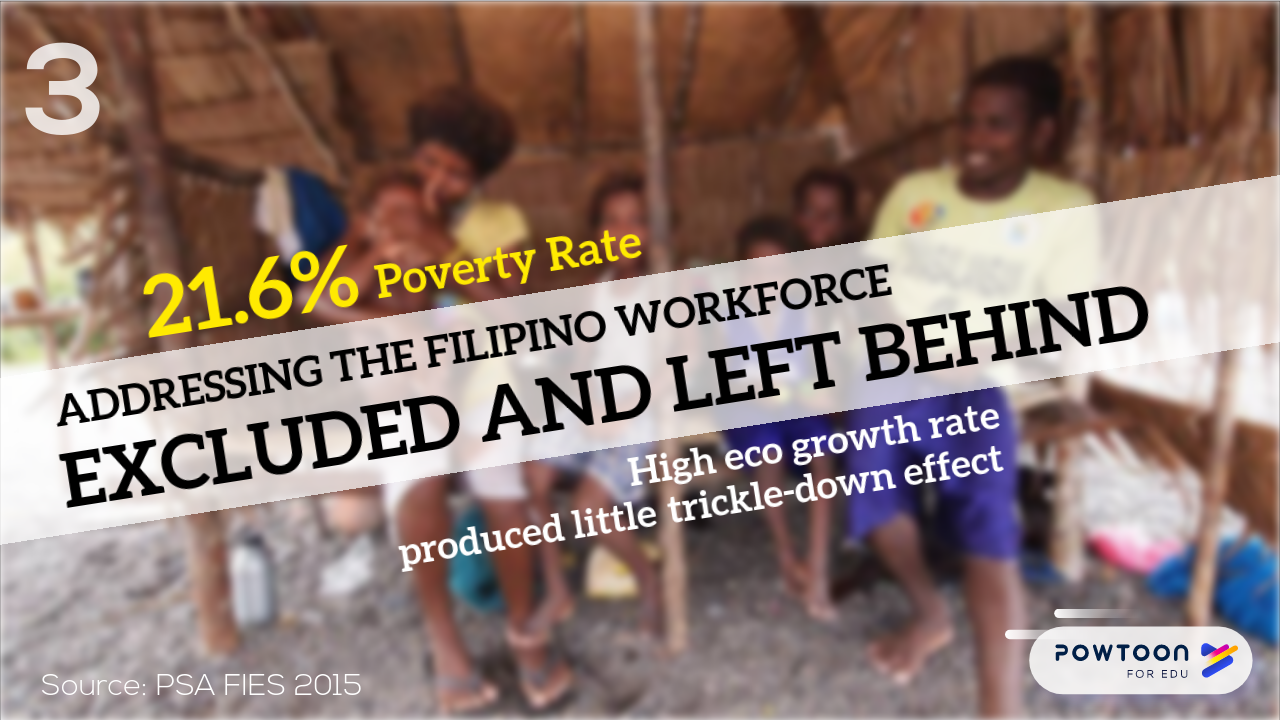 Access to TVET also poses a challenge. Limited funding and other resource limitations contribute to certain sectors not being attended to and reached by TVET. One such sector is the marginalized and disadvantaged poor, which government data in 2015 recorded at 21.6 percent.
Access to TVET also poses a challenge. Limited funding and other resource limitations contribute to certain sectors not being attended to and reached by TVET. One such sector is the marginalized and disadvantaged poor, which government data in 2015 recorded at 21.6 percent.
NTESDP Objectives
To address these problem areas and challenges, the NTESDP 2018-2022, has set five broad objectives:
- Create a conducive and enabling environment for the development and quality service delivery of the TVET sector;
- Prepare the Philippine workforce for the challenges posed by the Fourth Industrial Revolution;
- Assure industries with high economic and employment growth potentials and provide them the required quantity of quality workforce;
- Directly and more vigorously address workforce needs of the basic sectors and the disadvantaged; and
- Instill values and integrity in the conduct and delivery of TVET in the whole sector
The Strategic Responses
The achievement of these objectives is recognized to pave the way for changes on how the Philippines should view the world of work and influence and create new ways of thinking, learning, and working. The TESDA recognizes that this world of work demands more knowledgeable and skilled workforce, innovative and sustainable approaches, globally competitive standards, and ease of access and mobility for TVET stakeholders. The NTESDP is envisioned to address these demands. It has outlined strategic responses to address the five objectives. These are:
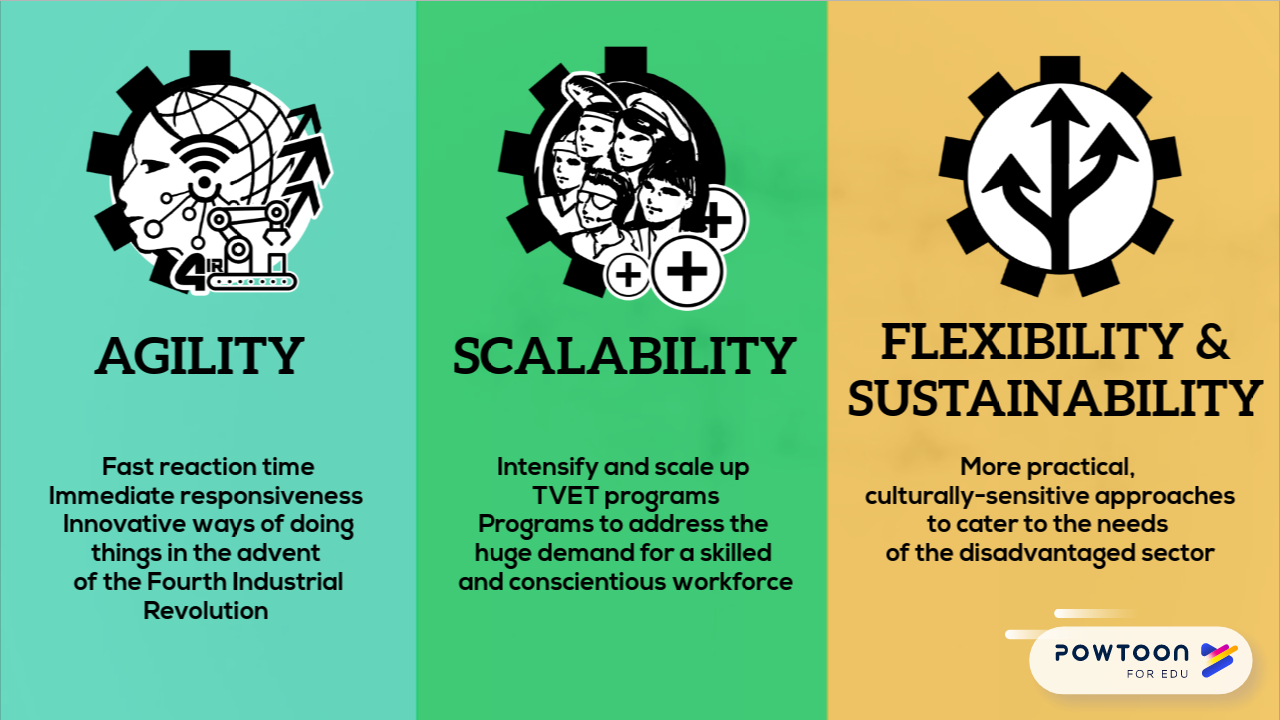
- TVET with Agility—to prepare the Philippine workforce for global competitiveness and future world of work;
- TVET with Scalability—to deliver high quantity job-ready, quality workforce; and
- TVET with Flexibility and Sustainability for social equity and economic inclusion.
These strategic responses are resolutely supported by organizational initiatives, as follows:
- TVET with Conducive and enabling environment, for development and quality service delivery; and
- TVET with Integrity, to instill sector credibility and client confidence.
These responses are designed to allow TVET to be vigilant and adaptable to changes in the sector. The NTESDP focuses on the preparation and anticipation of stakeholders’ needs through skills forecasting and anticipation and other research and development approaches; close engagement with clients to keep pace with their demands for the world of work and to be responsive with the needs of society in general; and the development of a comprehensive, inclusive and equitable service delivery to all Filipinos.
The NTESDP emphasizes convergence and collaboration of government units, industries, the academe, and relevant organizations for a successful, holistic service output.
TESDA’s Commitment
The TESDA, together with the TVET sector, commits to address the issues, problems, and gaps culled from the lessons of the previous Plans in order for the sector to remain relevant. In sum, the NTESDP 2018-2022 aspires to pursue and achieve Quality TVET for All.
